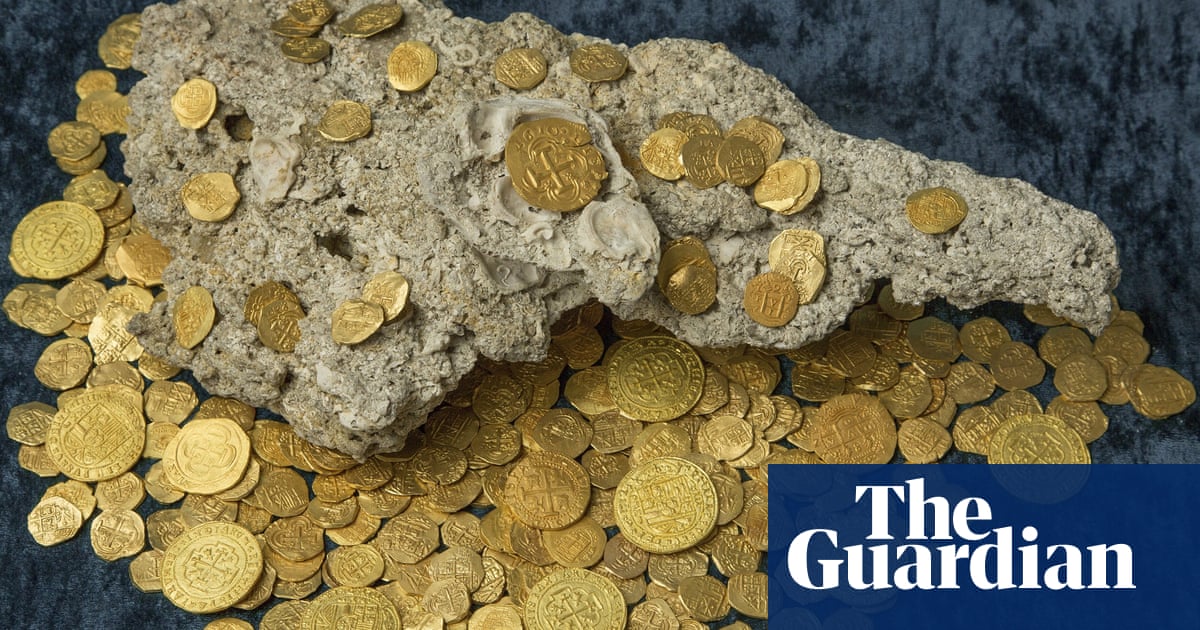
Since the Colombian navy discovered the final resting place of the Spanish galleon San José in 2015, its location has remained a state secret, the wreck – and its precious cargo – left deep under the waters of the Caribbean.
Efforts to conserve the ship and recover its precious cargo have been caught up in a complicated string of international legal disputes, with Colombia, Spain, Bolivian Indigenous groups and a US salvage company laying claim to the wreck, and the gold, silver and emeralds onboard thought to be worth as much as $17bn.
When Colombia tried to auction off part of the bounty to fund the colossal costs of recovering the ship, Unesco and the country’s high courts intervened.
But eight years after the discovery, officials now say they are pushing politics to one side and could begin lifting artefacts from the “holy grail of shipwrecks” as soon as April.
“There has been this persistent view of the galleon as a treasure trove. We want to turn the page on that,” Alhena Caicedo, director of the Colombian Institute of Anthropology and History, said. “We aren’t thinking about treasure. We’re thinking about how to access the historical and archeological information at the site.”
The San José was returning to Europe with treasures to help fund the war of the Spanish succession when it was sunk by a British squadron in 1708, close to the Caribbean port city of Cartagena.
Historians say the wreck could help reveal much about the Spanish empire at the height of its power – and the shared, overlapping histories of Europe and Latin America.
Eventually, Caicedo’s team hopes to raise the wreck itself, and put it on display in a custom-built museum where visitors will be able to explore “all the secrets of the bottom of the ocean”, she said.
But as the expedition continues to explore the site, the scale and complexity of the challenge is coming into focus.
Few ships like the San José have ever been recovered – and none has ever been salvaged from warm tropical waters.
“This is a huge challenge and it is not a project that has a lot of precedents. In a way, we are pioneers,” said Caicedo.
The closest comparison would probably be to the Mary Rose, the flagship of Henry VIII’s fleet, which sank in 1545 while in battle with the French fleet off the coast of Portsmouth.
That 16th-century wreckage was explored by hundreds of divers – many of whom were volunteers – for a decade before being carefully lifted in 1981. The surviving section of the ship’s hull is now on display in a £35m ($45m) museum.
Colombia’s navy has been studying the Mary Rose and other such marine conservation projects to see how it could lift and conserve the 40-metre-long ship and its contents without it all crumbling to dust.
“The San José is a very, very special ship. It’s comparable to the Mary Rose in that it was in action at the peak of Spanish technology and shipbuilding,” said Ann Coats, associate professor in maritime heritage at the University of Portsmouth.
“There are so many questions the San José could help answer!”
The San José’s cargo includes articles of glass, porcelain and leather, and historians hope the haul could inform their understanding of global 18th-century trade networks, Spain’s complex colonial hierarchy and the lives of the 600 souls onboard.
But while the Mary Rose lay in frigid coastal waters, the San José sank in deep, tropical waters which will probably have been cruel to the ship and could make the recovery one of the most costly and complex in history.
“The contents are really varied and we have no idea how the remains will react when they come into contact with oxygen. We don’t even know if it is possible to raise something out of the water,” said Caicedo.
The wreck’s precise location is a state secret to protect the site from looters, but Colombian authorities have revealed that it is 600 metres (2,000ft) below sea level – too far for divers to reach.
The country’s military is currently developing underwater robots that will first photograph, video and map the wreckage before carefully attempting any retrieval.
Exactly how much can be salvaged from the wreck will depend on myriad factors: currents, sea temperature, the type of silt the wreck is submerged in, how the ship’s 60 bronze cannons plunged to the seabed, and even which critters are now living there, says the head of the Mary Rose’s research program, Alex Hildred.
“It was also set on fire,” Hildred says. “Lifting the ship and creating a museum will be really difficult, really expensive and incredibly challenging … And then everyone wants a bit of it. It’s just a nightmare.”
The vessel’s international connections mean that historical research has until now been halted by international litigation over who is its rightful owner.
Although the wreck was found in Colombian waters, Spain has argued that the San José was part of the Spanish fleet and was returning from what was then part of the Spanish empire.
Meanwhile, Sea Search Armada (SSA), a US-based salvage company, has been locked in a legal battle with Colombia, arguing that it located the area in which the San José sank in 1981. SSA has argued that Colombia agreed to split any profits, but in 2011 a US court declared the galleon the property of the Colombian state.
Indigenous communities in Bolivia have also voiced a claim to any possible riches, arguing that their ancestors are likely to have mined the silver and gold used in many of the treasures.
The Colombian ministry of culture says the government has self-funded the first stage of exploration with $7.3m and it will not sell any of the precious artefacts as Unesco pleaded in 2018.
“Money has always driven the story of the San José. The British wanted to capture it to deny money to Spain, then the money onboard drove the archaeological search for the wreck,” said Coats. “Then disputes got in the way of studying the ship. It would be nice if for once money wasn’t driving things and a huge cultural collaboration could take place to study it properly.”
This article was amended on 18 March 2024. The Mary Rose was in the navy of Henry VIII, not “Henry XIII”. Also, it was likely to have been sunk by its instability during combat, rather than as a direct result of French fire, as an earlier version suggested.












